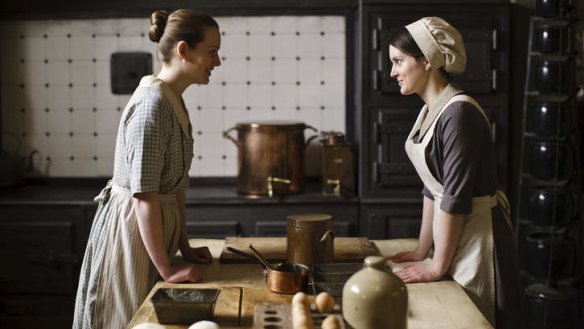How to make a Downton Abbey Christmas

I am hooked on Downton Abbey and wanted to make an Edwardian Christmas dinner. What should I serve and where should I get recipes? M. Fuller
Well you’ll need to prepare four different meals. For breakfast, ask the staff to make some boar brawn, kedgeree and eggs; chicken; duck; swan and quail. Naturally, then you’ll stroll about the estate, probably shoot something, before returning for a light lunch of Christmas pie filled with pigeon, pheasant, goose and foie gras washed down with a madeira. For afternoon tea at four you could have some mince pies followed by a brisk and athletic romp with one of the downstairs staff to build an appetite for a hearty Christmas dinner. This could include turtle soup, more eggs, some salmon from your river, roast turkey, plum pudding and Stilton. You could try The Unofficial Downton Abbey Cookbook by Emily Ansara Baines, but cookbook expert Tim White from Books for Cooks (booksforcooks.com.au) suggests going to the source material, such as the Edwardian edition of The Book of Household Management by Mrs Isabella Beeton, edited by Charles Herman Senn, or Senn’s The Century Cook Book. He also suggests a reputable spinoff from the Upstairs Downstairs TV series called Mrs Bridges’ Upstairs Downstairs Cookery Book. White says Edwardian cookery was the height of British cooking and after World War I, when the men were buried at the Somme and the estates were all sold off, there was a turn to bedsit cookbooks and meals for one, epitomised by Lady Agnes Jekyll’s 1922 Kitchen Essays, which included solitary dining pieces such as ‘‘Tray Food’’.
My sister is totally disgusted by the end of prawn tails and doesn't understand the retention of them in dishes. L Barton
If your sister is disgusted by prawn tails she'd puke if she saw my youngest make finger puppets out of their heads. She reenacted most of The Little Mermaid with the severed carapace of four barbecued king prawns dancing about on the end of her digits. I can understand that people don't want to know where their food comes from, it's a bit confronting. When you look at a prawn you can really see that it is just another crustacean; with all those legs it is just a swimming slater. Processing sees the removal of the head and much of the abdominal shell from a prawn, but leaves the sixth abdominal segment, telson and uropods – that's prawn talk for "end of the tail". This makes them much more presentable. Prawn tails without any shell simply look like proteinaceous commas and can appear could be made out of anything – which some of the imported farmed prawns taste like. The remnant shell also acts as little handles for those who eat with their hands.
How do chefs make "pink" onions? B. Nieman
I love those soft pink slices of onion decorating modern dishes. They originally started out as fine slices of red Spanish onion that were given a bit of instant pickling. This means they are given a good rub with some salt which draws water from the cells of the onion making it softer and denser. The addition of vinegar or lemon juice causes the anthocyans in the Spanish onion – these are beneficial compounds that give fruit and veg their deep purple colour – to change colour from purple to pink. The more acidic the compound added to anthocyans, the more red they become. Alternatively, if you add something alkaline to anthocyans, they become more yellow in colour.
When I've finished cooking I wipe my fry pans clean and season them with left over fat or oil. This drives my wife mad. She puts them in the dishwasher. What should I do? P. Checketts
In these situations I refer people a very useful online dating website called rsvp.com.au
Send your vexing culinary conundrums to brainfood@richardcornish.com.au or tweet @Foodcornish
The best recipes from Australia's leading chefs straight to your inbox.
Sign up